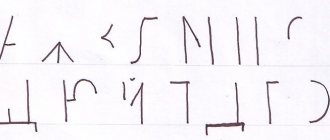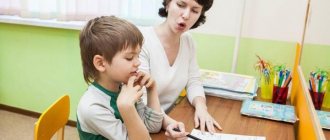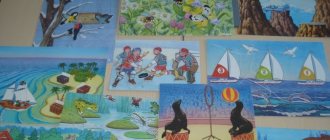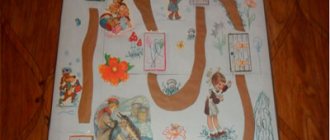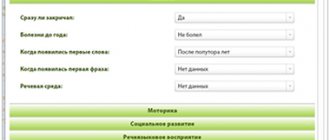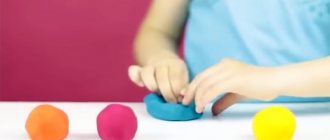The famous teacher V. A. Sukhomlinsky said that “the child’s mind is at the tips of his fingers.” Finger games are an unconventional form of speech development. They help use brain resources, developing memory, attention, and creative thinking.
In this article you will learn why finger games have a positive effect on the speech development of children, how to properly perform finger exercises in children of different ages, and what other non-traditional forms of children's activities stimulate the nerve endings at the fingertips.
How does finger development affect a child’s speech?
Finger games for speech development are a simple and accessible means of developing verbal intelligence. The famous academician V. M. Bekhterev, who studied the human central nervous system in the last century, proved that hand movements activate the areas of the brain responsible for speech.
Wernicke's area and Broca's area are responsible for speech development in the brain. Next to them are areas of the brain responsible for fine movements of the fingers. During finger exercises and other similar games, speech zones are simultaneously stimulated.
Psychoneurologists know that by observing the movements of a child’s hands and fingers, one can quite accurately determine the child’s level of speech development. The more accurate they are, the more developed the child’s fine motor skills, the closer to normal his speech is. Conversely, clumsy movements with poor coordination indicate that there is likely a developmental delay in the child's speech.
How to properly perform finger exercises up to 1.5 years old
The basic rule is that all exercises are performed at a slow pace and repeated 3-5 times. It is advisable to do them separately for the right hand, separately for the left hand. If finger exercises for speech development are accompanied by words, only an adult pronounces them. The text needs to be read emotionally and expressively.
How to do a simple massage of hands and fingers for a child under one year old
Since young children often have increased tone in their hands, their fingers are often clenched into a fist. To improve coordination of movements and develop fine motor skills, you need to regularly massage your child’s hands and fingers. This massage at 1 year of age is carried out in a playful way.
- We stroke the baby's hand from the outside and inside from the fingers to the elbow and back.
- Handles, hands! I know you, I wash you with water. I also know fingers, I play with them now.
- We stroke the fingers towards the palm and back, gently kneading each phalanx.
- This finger is the strongest, thickest and largest. This finger is for showing it. This finger is the longest and stands to the side. This ring finger is the most spoiled. And the little finger, although small, is very dexterous and daring.
- Gently tap your fingers in the direction from the pads to the palm.
- This finger is grandma, This finger is grandfather, This finger is daddy, This finger is mommy, This finger is me, That’s my whole family!
- Massage the fingertips by gently pressing on them. We massage the palms in a circle.
- The magpie-crow lit the stove, cooked porridge, fed the children, gave to this, gave to this, gave to this, gave to this, but did not give to this. He didn’t light the stove, He didn’t carry wood.
- We repeat the first exercise.
This massage is recommended to be done daily.
Exercises to develop fine motor skills of the hands
All exercises are carried out in a playful way, since at this age play is the leading activity.
- "Fisherman". Using a small net, which you can make yourself, catch pieces of cork, foam plastic, large beads from a bowl of water and place them on a plate. We hold the “fishing rod” with one hand.
- "Track". Fill the “path” with semolina or millet, the borders of which are lined with cardboard or paper strips. Cereals cannot be spilled outside the “path”.
- "Magic Spoon". Pour the cereal from one cup to another, carefully taking it with a spoon. Then you can repeat everything in the opposite direction.
- "Firework". Tear the thin paper into small pieces, fold them into your palm and throw them up.
- "Paper ball". Crumple a sheet of paper into a tight ball.
- "Magic Wands". Make a path, a Christmas tree, or a house from counting sticks. Carefully collect them in a box, taking one piece at a time.
The set of exercises ends with a relaxing massage of the arms and fingers.
Nursery games
Folk traditions of raising children, starting from the early months of a baby’s life, included nursery rhyme games with fingers and hands.
- "The white-sided magpie". The well-known nursery rhyme can be complicated by bending the “obedient fingers” to the palm and playfully shaking the “lazy” little finger.
- “Okay, okay.” We clap our hands, holding the baby’s hands in our hands and saying: “Palms, clapping hands, ringing clappers, clap your hands, clap a little.”
- "Animal Houses". An adult can help the baby by holding his hands by the wrists.
- The bear has a big house - oh-oh-oh! (we spread our arms to the sides). And the hare has a small one - ah-ah-ah! (hands together) Our bear went home (“we stomp our hands” on the table), Zainka lay down, bainki! (hands near cheeks)
- «
Hide and seek."
- The fingers play hide and seek, open (open your palm), close (clench your fist). -Knock-Knock! (knock fist on fist) Yes, yes, yes! (clap our hands) Can I come to you? (knock fists) Always happy (claps)
You need to play with your baby in a fun, emotional way, when he is in a good mood.
Games with rubber toys
Rubber squeaky toys are an excellent tool for improving finger motor skills and speech development in the first year of a baby’s life. By squeezing the toy, the baby quickly begins to understand what causes the squeaking sound. Then he reproduces it deliberately. The pressure of the material from which the toys are made massages the fingers and affects the speech areas of the brain.
Natural finger exercises – water, sand
Sand and water develop sensitivity in the fingers and kinesthetic sensations.
By plunging his hands into the sand, sifting it between his palms, squeezing and rubbing, the baby performs self-massage. The impact of sand of different structures, temperatures and humidity on nerve endings simultaneously promotes speech development.
Sand games:
- make handprints on wet sand;
- draw lines, zigzags and simple shapes with your finger;
- hide small toys and pebbles in wet sand;
- bury your palm in the sand and take out your fingers one by one;
- show how the fingers “walk” and “jump” in the sand.
Playing with water relieves hypertonicity in the fingers and hands and increases range of motion. The contrast in the temperature of water and air, as well as the temperature of water in different containers, hardens the baby and increases the sensitivity of the fingers. The optimal time for playing with water is no more than 5-7 minutes.
Exercises with water:
- "Warm, cold". The child bathes colorful fish, balls and other toys alternately in cool and warm water.
- "Catch a piece of ice". The child uses a net to remove pieces of ice dropped into it from the water. You need to hold the net with only one hand and place the pieces of ice on a plate.
- “Take the shell (pebble) out of the water.” The kid takes out one shell, which his parents previously showed him, from the total mass lying at the bottom.
- "What floats". Dip objects with different properties into the water: fabric, pebbles, a rubber toy, a paper boat, a piece of polystyrene foam. Observe what floats, what sinks, what gets wet. Take out objects, examine them, touch them.
After playing, you need to wipe your hands with a dry towel and switch your baby’s attention to another activity.
Progress of the lesson:
Speech therapist. What do we do when we want to strengthen the muscles of our arms and legs? Let's do gymnastics ! Our cheeks, lips and tongue also have muscles. Let's teach the mouth to open and close on command, the lips to move smoothly and beautifully, and the tongue to be smooth and obedient.
1. Preparation of articulation organs: elements of speech therapy massage (stroking, patting, aimed at relaxing the tongue, overcoming increased tone in the tongue.
2. Breathing exercise “Snowflakes”
.
Place a piece of cotton wool on the child’s and encourage him to forcefully exhale air through his lips, stretched forward like a “tube”
. At the same time, inhale through the nose, without raising your shoulders, and when exhaling, do not puff out your cheeks.
3. Articulation gymnastics .
Now we will play with our tongue and lips in front of the mirror.
A set of articulation exercises according to L. A. Komarova.
4. Game “Catch
the sound [C] ” (Isolating
the sound [C] by clapping the ear ) The speech therapist pronounces a series of sounds , and the child must “catch”
the sound [C] - with his hands , i.e. clap when he hears the sound [ WITH] .
5. Finger gymnastics .
On a laptop we demonstrate a slide presentation “ Finger gymnastics with a ball ”
and perform sequentially
(
child and speech therapist ) exercises with a massage ball.
6. Exercise “Pump”
.
In order to correctly pronounce the sound [C], you need to smile, rest the tip of your tongue against the lower teeth, and press the lateral edges of the tongue tightly against the upper lateral teeth; there is a strong cold stream of air running down the middle of the tongue (demonstration)
.
Look at the picture, the bike’s tires are flat, let’s try to help him inflate them. The air comes out of the pump and whistles [ss-s-s-s-s-s-s] (practice imitation exercise)
.
7. Exercise “Tracks”
.
(using tactile boards)
.
The child runs his finger along the path and pronounces the sound [C] , reaching the end of the path he adds the sound [A] . Let's see what syllables we can come up with.
Repeat the syllables according to the pattern:
Vocabulary material: SA-SO-SU-SY-SE
8. Physical school
.
What sound did we learn to pronounce correctly?
Source
How to properly perform finger exercises up to 3 years old
Finger exercises for speech development at 1.5-3 years old can be accompanied by the display of pictures. First you can show a bright colorful image, show it, and then do the exercise. Over time, the baby will learn the material and remember what to do. The gymnastics is completed with a light massage and stroking of the fingers and arms.
Warming up your fingers before the main exercises and games
In order for finger games for speech development to bring maximum benefit, proper preparation for them is important. It’s not difficult at all – just warm up your palms by rubbing them together. If the baby finds it difficult to do this himself, the mother should help him.
In addition to this, you can gently stroke your fingers from the pads to the palm and vice versa. It will not be superfluous to gently rub your hands from hand to elbow and back. All influences are performed very carefully and carefully so as not to cause a negative reaction from the child.
Clap games
These games are a variation of the game “okay”. They develop fine motor skills, a sense of rhythm, attention, and muscle memory. The poetic texts accompanying the claps can be chanted or recited. You can clap in your own hands, in your partner’s hands, on the body, on the table.
- "Vegetable Garden" .
Children clap their hands or their parents' hands.
-We have a vegetable garden and grow dill, tomatoes and lettuce on it.. Our vegetable garden is just a treasure! There is parsley and beans, Cucumbers, radishes, carrots, Zucchini and squash, Beets, radishes, green onions, And, of course, zucchini, And watermelon, and even melons. Have you planted everything you can? (spread your arms to the sides) We didn’t miss anything.
- "Dance with a cat" .
Accompanied by rhythmic clapping.
The cat was getting married, she invited us to the wedding, we will dance with her to please the guests.
- "Doves"
- The doves flew to the green meadows (we wave our wings), They drank, they ate, They sat near the shore (we clap our hands), They got drunk in the cold, They rushed along the river, Shu! (we flap our wings).
Educational poems for finger games
If the poems accompanying finger gymnastics are meaningful and interesting, the benefit of such a correction doubles.
- Kittens
All the kittens washed their paws: That's it! Like this! (imitation of washing), We washed our ears, we washed our bellies: That’s it! Like this! And then they got tired: That's it! Like this! They fell asleep sweetly: That's it! Like this! (sleep simulation)
- Small birds
Little birds, Small birds. They fly through the forest, sing songs (we wave our arms like wings), a violent wind has blown (hands up), they wanted to carry away the birds. The birds hid in the hollow (covered their heads with their hands). It was cozy and warm there.
- Two arms
Look, here are two hands: right and left! (show hands) They can clap their hands - both right and left! (clap), They can pinch my nose - both the right and the left! (press) Both the right and the left can cover their mouth with their palm! I am always friends with my hands – both my right and my left! (handshake) And both the right and the left can be affectionate! They will hug you, they will press you to me - both the right and the left! (hug ourselves)
Games that develop creativity and speech
Such finger games for early preschoolers are necessarily accompanied by the display of pictures or toys or objects. In children aged 1.5-3 years, visual-figurative thinking predominates, so they learn the material better.
Creative speech games are good because they solve several problems at the same time. Such games have a positive effect on fine motor skills of the hands, develop memory and attention, and stimulate speech development.
- "Fairy tales"
- Let's count our fingers, Let's name fairy tales (play with our fingers). This fairy tale “Teremok”, This fairy tale “Kolobok”, This fairy tale “Turnip” About a granddaughter, grandmother, grandfather (we touch the other fingers with our thumb). “The Wolf and the Seven Little Goats” - Everyone is happy about these fairy tales!
- «
Pets" While reading the text, alternately show the fingers on one and the other hand.
The cow is happy with her calves, the sheep is happy with her lambs, the cat is happy with her kittens, who is the pig happy with? Piglets! The goat is happy with her kids, and I’m happy with my kids! Oh, a mosquito is flying here! Hide your hands! (put it behind the back)
- "Snowball"
One, two, three, four, (we bend our fingers), You and I made a snowball (sculpt), Round, strong, very smooth (we imitate stroking the ball), One – we’ll throw it, Two – we’ll catch it, Three – we’ll drop it And... we’ll break it! (stomp our feet)
After the games have been mastered, you can try to give the kids independence and invite them to show themselves what is said in the poetic text.
Drawing
While drawing, a preschooler uses muscle, visual, and tactile analyzers.
Memory, attention, the ability to analyze are additional advantages obtained during this creative process in addition to the development of fine motor skills. At the age of 1.5-3 years, it is better to use finger paints and large sheets of paper. You can take whatman paper, the remains of wallpaper. It is advisable to use no more than 2-4 colors, it is better to start with red and yellow. In this case, water is not used.
Drawing should be done as long as the child has the desire. The duration of classes is from 1-2 to 15-20 minutes. The lesson time increases gradually.
Modeling
This is one of the favorite activities of kids, which perfectly develops the sensitivity of nerve receptors on the fingertips. Coordination of hand and finger movements, new tactile sensations have a positive effect on speech development. To begin with, it is best to use the plasticine technique, since young children love to smear plasticine on any surface.
To do this, draw a simple silhouette (house, tree, beetle, cup, sun) on cardboard or a thick sheet of paper and show the child how to fill the outline with plasticine. The explanation can be accompanied by a finger game or a nursery rhyme.
Application of pasta, leaves, cereals
Manipulations with cereals and pasta are very useful for developing fine motor skills of the hands. Handling the cereal with your fingers and pinching movements have a positive effect on sensory development. In addition, they develop attention, creativity, attention.
An important rule is that you should always follow safety precautions and ensure that your baby uses the cereal for its intended purpose.
The simplest application is to sprinkle semolina or millet on a silhouette of a simple shape, previously coated with glue. The excess is shaken off and patterns or images of familiar objects magically appear on a sheet of paper.
The “pasta” applique is performed in the same way, only these products are laid out along the contour manually. Stars, spirals, waves and shells, bows and spaghetti can be painted with gouache or food coloring.
Dried leaves and flowers are an excellent material for non-traditional appliqué. These fragile components require careful handling, which forces the child to more accurately coordinate the movements of his hands and fingers. The leaves are laid out on a contour image of a simple object or in the form of a symmetrical pattern.
Natural exercises for fingers - fastening buttons, making figures from dough
The abundance of zippers and Velcro fasteners on children's clothing has deprived children of the opportunity to naturally develop finger dexterity. To compensate for this, you can make your own finger trainer. It is a set of buttons and matching loop fasteners.
You can play around with this simulator by making it in the form of a funny little animal, a sun with attached rays, or a turtle with a removable shell. It is advisable that the loops are not too tight and the buttons are not too small. For a successful training, it is important to create the right motivation: help the bunny button his jacket, otherwise he will freeze.
Modeling from salt dough is another means of developing fine movements of the hand and fingers of a young child. Massage of the fingers, which accompanies modeling from a soft and light material, has a positive effect on the baby’s sensory development and speech development.
It is impossible to taste this dough as it is salty. Crafts made together with mom can be painted, dried in a slightly heated oven and played with for a long time.
How to properly perform finger gymnastics up to 6 years old
Older preschoolers can do finger gymnastics following verbal instructions. It is enough to name the exercise, and children immediately remember both the text and the movements. They can already stage a “finger tale” and tell a familiar story. For variety, you can turn on music, put caps, hats, masks on your fingers, and come up with a problem situation.
Games with sticks and matches
Cocktail sticks, ice cream sticks, matches with broken sulfur heads, counting sticks are excellent materials for developing fine motor skills. The different surface structures train the sensitivity of the fingers and develop sensory memory. By laying out patterns and different figures, children develop imagination, perseverance, and spatial thinking.
Possible options for tasks - how you can play:
- throw matches into the piggy bank, filling it to the top;
- make a hedgehog or a Christmas tree out of plasticine, decorating it with thorns from matches;
- collect 10 matches from the table with one hand, without releasing them from the fist;
- lay out rails and sleepers from sticks of different colors;
- build a long and short, narrow and wide path, let toys run along them;
- build a house, a car, a boat, an airplane, and various letters out of sticks.
You can cut out fairy tale characters from an old book, glue popsicle sticks to them and show a puppet theater.
Games that develop creativity and speech
Children of senior preschool age can already act out the plot told in the poem themselves.
- Washbasin
We opened the tap: chick-chick, (rotate the brush), We washed our hands: chic-chic, (three palms), Let the water run, (smooth movements), We wash our face (wash ourselves). We rub our palms with soap (wash our hands), and get wet with a towel (clap our palms). Here are our clean palms (show), We'll clap a little! (clap)
- Mistress
I will cook porridge for the doll (imitation of stirring), pour milk into a bowl, put cereal there (with three fingers), and put it on the stove. (palms forward) The porridge will be good (claps your hands), Eat, doll, slowly! (threaten)
Games with paper
The different structure of thick and thin, silk and corrugated paper, its folding and unfolding, the ability to tear and roll into a tube, cut and glue, folding figures using the origami technique is of great value for the development of motor skills of the fingers and the development of speech.
Games with paper:
- folding a sheet of paper with an accordion or screen, starting with a thin sheet and ending with thick cardboard;
- winding a strip of paper onto a round or ribbed pencil, gluing them along their length;
- cutting paper into strips and gluing into a paper chain;
- tearing paper into small pieces and folding them into a picture.
Shadow theater of hands
Shadow theater is magic that you can do with your own hands. In addition to the fact that the scenery and characters can be made from available materials, sometimes a pair of hands is enough to depict the characters in the play. If you arrange your hands and fingers in a special way, you can get a goose, sheep, donkey, cow, dog, turtle and other animals.
Tell poems with your hands
This type of activity is always interesting for children. They develop fine and gross motor skills, attention, memory, and their mood improves. You can show not only the content of lines, but also individual words. Not all poems are suitable for telling with your hands. They are selected or composed specifically for these purposes:
- Peas
- They poured peas into a bucket and let their fingers run in, causing a commotion there, so that the fingers wouldn’t be sad.
- Beans
- There is not salt in the bucket, not salt at all, but multi-colored beans. There are toys for children at the bottom, We can get them out without any fuss.
Homemade crafts
It is difficult to overestimate the benefits of this type of activity for child development. Arts and crafts or creative needlework will allow the child to express his abilities and decorate the children's corner.
The benefits of making crafts with your own hands - what shapes:
- perseverance;
- fine motor skills;
- attentiveness;
- accuracy;
- imagination;
- the opportunity to create a unique item.
The different structures of fabric, threads, paper, felt by the fingers, manipulations with tools stimulate nerve receptors, making the fingers more dexterous, developing the speech areas of the brain.
Types of needlework:
- sewing doll clothes and household items;
- weaving jewelry from beads and seed beads;
- crochet and knitting;
- embroidery;
- modeling products from polymer clay and salt dough.
Natural finger exercises – tying your shoelaces
The ability to tie shoelaces is extremely useful for the development of fingers and stimulation of the speech areas of the brain. If it is not possible to practice on your own shoes, you can purchase a special trainer or make it yourself.
You need to start learning at the age of 4-5, not earlier, since the child must know where his right and left hand are. To make his task easier, you can paint both parts of the lace in different colors. You need to show how to lacing while standing or sitting behind the child. Mirroring is prohibited.
- — Are you trying to knit shoelaces? Don't worry - it's nothing! Take the lace. Loop, hook. Hooray! A knot comes out! Now they need to be tightened, threaded here and turned. A loop, an eyelet, and now - the shoes won’t fall off!
Difficult level
The third level teaches the coordination of individual fingers and their opposition. Working out this kind of movements helps to reproduce “S” on demand at any moment of speech.
Stepan has a sweet dream - the children cover their eyes with their hands
Sees fresh sour cream - open their eyes wide and lick their lips with a circular movement of the tongue clockwise
In a familiar blue bowl - the palms of both hands need to be joined so that a depression is formed - we depict a bowl
And he has a spoon with him - now the bowl is represented by one bent palm, and the protruding index finger of the other hand is a spoon. The child makes circular movements of the thumb on the “palm-bowl”
He eats sour cream with a spoon - his thumb “scoops up” imaginary sour cream and brings it to his mouth. You can depict chewing movements.
Stepan dreams about all this - they cover their eyes with their palms again
Then alternately connect your thumbs with others, getting new rings and training fine motor skills.
You should praise the child when he succeeds, because positive emotions make it much easier to produce the “C” sound. Kids like rhyming speech, which means that classes will proceed without much difficulty and will bring the greatest benefit.
The role of finger exercises should not be exaggerated - it will not replace full-fledged physical education, nor will it replace communication between mother and child. Finger skills are very necessary, for example, for working on a computer or mobile phone. And having trained fingers that can quickly perform quick coordinated actions is very useful.
Source
Correctional complex for children 1.5 – 3 years old
An adult demonstrates all exercises in advance, accompanying the demonstration with an explanation.
- The palms are on the table. On the count of “one” - fingers apart, “two” - fingers together.
- As we count, we alternate hand positions: fist – edge – palm.
- “The little man runs around the table,” first his left hand, then his right, then both hands together.
- “Children run a race” is performed similarly to the previous exercise.
- “Trees” - raised their hands up, spread their fingers to the sides.
- “Finger is a boy.” Bend the baby's fingers under the nursery rhyme:
- Thumb-boy, where have you been?
“I went into the forest with this brother.”
I sang songs with this brother,
I cooked cabbage soup with this brother,
I sang songs with this brother.
The thumb touches the pads of all fingers in turn, from the index finger to the little finger.
For beginners
Exercises vary in difficulty. Young children, as well as those kids who are not familiar with such work, should start from the first level. These tasks for the hands develop the ability to imitate, hold the tension in the hands for a while and switch attention.
A fairly simple exercise, suitable for children 2-3 years old, since it does not require complex coordinated movements of the fingers and facial muscles.
Jumping, jumping in the woods (jumping on the spot)
Hares are gray balls (jumping, holding their hands to their chests).
Jump - jump, jump - jump - (jump forward and back)
The little bunny stood on a stump (straighten up and put his hands on his sides).
Lined everyone up in order (turn your body to the right, move your right arm to the side, then to the left and extend your left arm to the side)
Began to show charging.
Once! Everyone walks in place. (marching in place)
Two! They wave their hands together (hands in front of them, making “scissors”)
Three! They sat down and stood up together. (sit down, stand up)
Everyone scratched behind the ear. (scratch behind the ear)
They reached for “four”. (hands up, then to chest)
Five! They bent over and bent over. (bend over, lean forward)
Six! Everyone stood in a row again (stand straight, hands to chest)
They walked like a squad. (marching in place again)
Correctional complex for children 3-6 years old
Older children can already follow an adult's instructions and control their movements. They are offered more complex exercises:
- Three palms touch each other until a feeling of warmth appears.
- We clench our hand into a fist and unclench it.
- We hook our hands into a “lock” and pull our hands in opposite directions.
- The hands remain in the “lock”; we move the clasped hands back and forth.
- "Sun". We raise our fists with clenched fingers (the sun is rising), then open our fingers (the sun is shining).
- "Fingers say hello." In turn, we connect the thumb with the rest, making a ring.
- "Football". A finger rolling a paper ball imitates the foot movements of football players.
- "Scissors". We cut paper, fabric, oilcloth for make-believe.
- We place our palm on the table, raise our fingers one by one, and repeat with the other hand.
Fine motor skills test by M. A. Povalyaeva
The purpose of the test, proposed by the candidate of pedagogical sciences M. A. Povalyaeva, is to determine the norm and pathology of the activity of certain parts of the cerebral cortex. It is so simple that parents can easily do it at home.
To carry it out, you need to sit opposite the baby and cover one of his hands with your hand so that he does not see it. Then mom or dad touches the fingers of the “hidden” hand in a free manner. At this time, at the request of the parents, the baby unclenches the same finger of the other hand, clenched into a fist.
Well-being parameters – what children should determine at different ages:
- 3 years – thumb;
- 5 years – thumb and little finger;
- 6 years – index finger, thumb, little finger.
Children with parents or teachers who regularly engage in finger play and sensory development will pass this test without difficulty.
Main conclusions
One of the simple and effective means for developing children's speech is finger games. They can be used starting from the first months after the birth of the child. The areas of the cerebral cortex responsible for speech and finger movements are nearby.
To stimulate the fingers, nursery rhyme games, games with rubber toys, games with water and sand, drawing, modeling, appliqué from cereals and pasta are used.
Older preschoolers stimulate nerve receptors on their fingers by playing with paper, showing shadow theater, doing homework, and reciting poems with their hands.
To correct speech development, you can use finger gymnastics complexes intended for early ages. There is a simple and convenient test by M. A. Povalyaeva to measure the level of development of fine motor skills, which can be carried out at home.
If you liked the article, please share a link to it
Increasing difficulty
The second level requires more precise, but static actions, thanks to which “S” will be pronounced much easier.
For each line of the poem it is necessary to make movements of the fingers, lips or tongue. Children must recite the verse.
Stepan has a sweet dream (children cover their eyes with their hands)
Sees fresh sour cream (open eyes wide and lick lips in a circular motion of the tongue clockwise)
In a familiar blue bowl (the palms of both hands need to be joined so that a depression is formed - we represent a bowl)
And he has a spoon with him (now the bowl is represented by one bent palm, and the protruding index finger of the other hand is a spoon. The child makes circular movements of the thumb along the “palm-bowl”).
He eats sour cream with a spoon (his thumb “scoops up” imaginary sour cream and brings it to his mouth. You can imitate chewing movements).
Stepan dreams of all this (they cover their eyes with their palms again).
